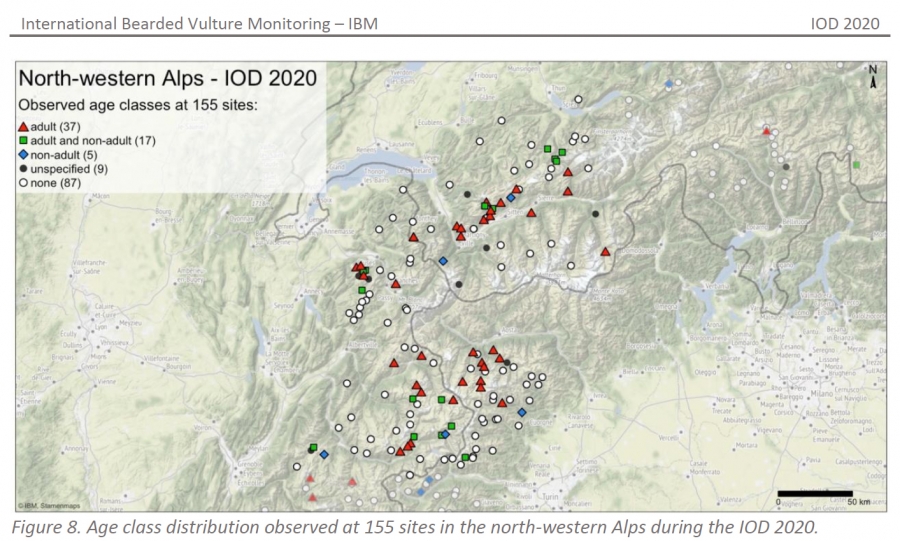The International Bearded Vulture Monitoring network has recently released the report on the 15th International Observation Days that took place across the Alps and beyond, in October 2020. Once again, many Alpine Protected Areas took part in the event such as Nationalpark Hohe Tauern, Parco Nazionale Gran Paradiso, Parc National De La Vanoise, Parc National Du Mercantour, Parco Alpi Cozie, Parco Naturale Alpi Marittime - Waon, Parco Nazionale Dello Stelvio / Nationalpark Stilfserjoch and the Réserves Naturelles de Montagne de Haute-Savoie managed By Asters.
The International Observation Days (IOD) are an annual monitoring event for Bearded Vultures organised by the International Bearded Vulture Monitoring network (IBM). The monitoring action takes place in the first two weeks of October with a synchronous and coordinated survey on the focal day and covers large parts of the Alpine arc, parts of the Massif Central, the eastern part of the French Pyrenees, several regions in Spain, some selected sites in Bulgaria and the High Atlas.
The aim of this expanding network is to establish a Europe-wide monitoring of the Bearded Vulture population where time-synchronised observations on the focal day allow to make an approximate estimate of the population size and age class distribution. A monitoring action of this scale and the fact that birds are identified on an individual level whenever possible, is unique and generates baseline information for survival analyses and demographic modelling, which give valuable insight into the reintroduction progress. Furthermore, the number of participants during the IOD increases every year and thus the IOD represents a big public event that helps to increase awareness for the conservation of the Bearded Vulture as a flagship species.
IOD 2020 ACROSS THE ALPS:
Despite the unfavourable weather situation in most of the Alpine range on this year’s focal day (3.10.2020) more than 790 observers joined the IOD 2020 and reported 483 Bearded Vulture observations. In order to obtain a reliable Alpine population estimate, synchronous monitoring over a large part of the area is necessary to avoid double counting. However, due to limited access or poor visibility in many regions, the monitoring network could not be covered as in previous years. In addition, it must be assumed that fewer Bearded Vultures were observed flying at sites with bad weather, as a consequence of the unfavourable thermal conditions. Because of these limitations, no reliable estimate of the Alpine Bearded Vulture population or its age class distribution could be made in 2020. Nevertheless, in the Alps it was possible to identify 27 Bearded Vulture individuals with certainty, while a further 22 birds could be identified with slightly lower probability. These data provide important information on the life-history of these animals and can serve to calculate parameters for demographic modelling.
The full report of this 15th International Bearded Vulture Observation Day can be download here : http://www.gyp-monitoring.com/cms/resources/download.php?file=report_iod2020.pdf
The publication of this IBM report is also the opportunity to share two good news from our network:
IN THE GERMAN ALPS – Berchtesgaden National Park & LVB
More than 100 years after its extinction by humans in Germany, two young bearded vultures from Spanish offspring will be poached for the first time on 10 June as part of a project of the Bavarian nature conservation association LBV in the Berchtesgaden National Park. LBV and the only Alpine National Park in Germany are participating in an international project to resettle the bearded vulture in the Alps.
Full press release (in German) : http://alparc.org/images/News/News2021/BeardedVulture_Berchtesgaden2021.pdf
IN THE FRENCH ALPS – Vercors Regional Natural Park
In 2021 in France, 18 pairs of bearded vultures breed in the Alps and 48 in the Pyrenees. While some reproduction failures have been noted, vulture births have been observed at the same time since March.
In the Vercors Regional Natural Park, two birds, respectively from Bulgaria and the Czech Republic, joined the Tussac site in the town of Châtillon-en-Dois on May 23, 2021 where they were released into the cavity prepared for this purpose. A webcam has been installed to share the surveillance with the general public and perhaps capture the moment of the birds flight when they are ready: https://gypaete.parc-du-vercors.fr/gypaete.jpg?fbclid=IwAR0aDh8_n9FE-w9wW0aY0U41AZvy5-nH2hXcgR2A-C3tLc8Z1QuhQ4W0nOo


